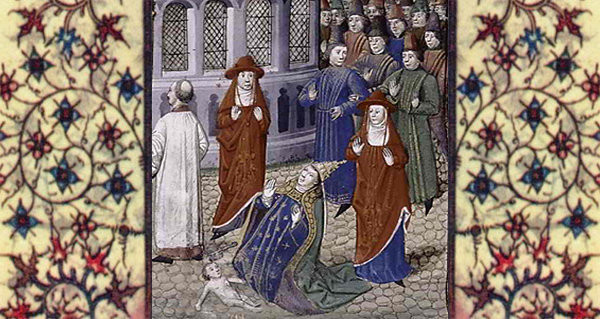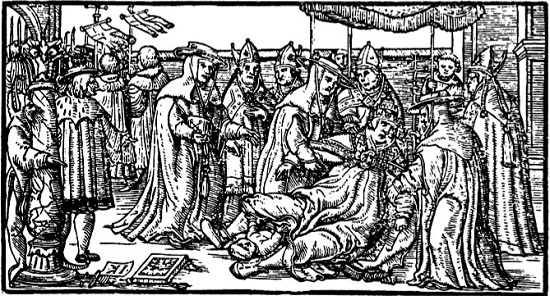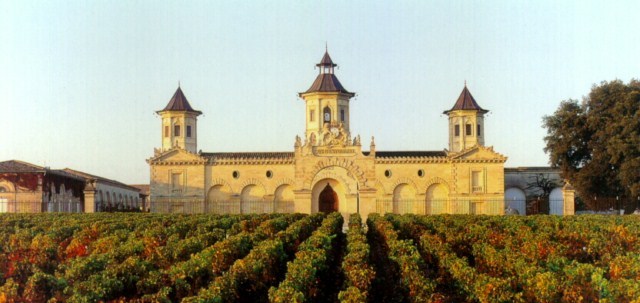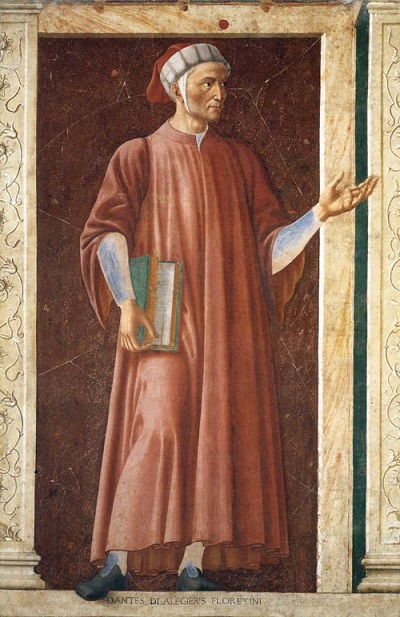
In the oratory at the junction of Via Santi Quattro and Via dei Querceti, Rome there is a painting in a very poor condition that has often been interpreted as a memorial of the scandal of the legendary Pope Joan, who gave birth in the street, however, the fact is that it is simply an image of a Virgin and Child.
But who was Pope Joan, and why is there such a scandal about her and the anti-papal satire that surround her? Well, here is a little about her….
It is said that on the death of Pope Leo IV, a young man from the German city of Mainz was elected pope under the title of John VIII and supposedly reigned from 853-855 [the pontificate of Leo IV in fact lasted until his death in 855, and Benedict III succeeded him a few weeks later]. The young man in question was really a young girl who had just arrived in Rome disguised as a man, after studying in Athens. As she excelled in literary and scientific argument, she gained the respect of a number of academics. Still dressed in male attire, she quickly surrounded herself with followers and became so celebrated that she was made pope. Struggling with great difficulty against her natural desires, however, the young woman grew infatuated with a handsome cardinal, who at first was annoyed by the way she was looking at him. But his irritation soon melted as he realised that the pope was really a young and beautiful Papessa. The two clerics wasted no time in becoming lovers, and uniquely in the history of the Church, the pope fell pregnant.
The story goes on to say that one day, on the processional route between the Lateran and Saint Peter’s, the Papessa’s water broke and she gave birth in the middle of the road, near Saint Clement’s church. The place is marked with a stone slab and the street, which no longer exists, came to be known as Vico della Papessa.

It was only in the writings of Martin de Opava, a Dominican monk, that Pope Joan’s male name was written down. According to Opava, the name that Pope Joan used when disguised as a male was John Anglicus and it was Opava who named her birthplace as Mainz. There is also some thought that Pope Joan could have been Pope John XX, and as there is no record of a Pope John XX or Pope John XXI in papal records, this idea has been given some credence.
Pope Joan’s name does not appear today on the list of holy pontiffs in an attempt to eradicate the memory of this shameful incident. Moreover, the legend has it that thereafter it was stipulated that during a pope’s consecration ceremony, two cardinals must verify the sex of the new candidate by seating him on a seat with a hole in it (a commode), to check his attributes, and that after verification, they should declare: “Habet duos testiculos et bene pendentes” (he has two well-hung testicles). But this story has been rather discredited by the existence of “commodes” manufactured long before the election of the Papessa.
The Church officially denied the legend in 1570, but it is said that until then the Easter processions carefully avoided the Vico della Papessa. In fact, the papal processions never used that street.
Whatever the truth about Pope Joan, she has featured as the subject of movies, TV documentaries and numerous books, and doubtless the controversy around her will continue to ensure that her name and her legend live on.










